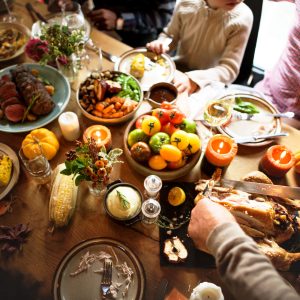
Food and family are two major components of a Thanksgiving Day celebration (along with football, giant parade floats and pre-Black Friday shopping). As you gather around the table, you’ll likely chat about the weather, get the latest updates from the out-of-town cousins, and probably hear about someone’s bad back or trick knee. If there’s ever a lull in conversation, we thought we’d give you some science to share. After all, sharing science is kind of our thing.
And what a perfect occasion for it.
Look around the table, and you’ll find a different genetic triumph in every dish. Some of them are happy accidents; some of them stem from careful human guidance. Most of them are delicious. We’ll let you all fight it out over which ones those are.
Turkey Day
Thanksgiving starts with the turkey, and so will we. The U.S. Department of Agriculture estimates that Americans eat more than 45 million turkeys every Thanksgiving. You don’t have to be a geneticist to see the origins of the name ‘Turkey Day.’ But if you do happen to be a geneticist, or now a Shareable Science reader, you know that the turkey itself is a fascinating example of genetic selection.
Benjamin Franklin once argued in a letter that the turkey would make a more fitting national bird for America than the bald eagle, noting that the bird was uniquely native to America and “a bird of courage, [that] would not hesitate to attack a grenadier of the British guards.” That description, in part, feels so different from the turkey we think of today because the wild bird described by Franklin was a pretty different animal.
“Ancient turkeys weren’t your Butterball,” said Rob Fleischer, head of the Smithsonian Conservation Biology Institute’s Center for Conservation and Evolutionary Genetics in a 2012 release. “We set out to compare the genetic diversity of the domestic turkeys we eat today with that of the ancestral wild turkey from South Mexico. Some of what we found surprised us.”
Today’s commercial turkey is descended from birds initially domesticated in modern-day Mexico as early as 800 B.C. In the early 1500s, Spanish Conquistadors encountered these turkeys and shipped them back to Europe, where they became something of an instant hit.
The researchers compared the genomes of seven commercial turkeys to samples from three turkeys collected in 1899 from Mexico and preserved in the Smithsonian’s National Museum of Natural History. They discovered that the breeding of turkeys – selecting for birds with the desirable traits of large body size and increased breast meat – has dramatically reduced the genetic diversity of the commercial species, even when compared to other domesticated farm animals like pigs and chickens. Identifying genetic differences between wild and commercial turkeys may uncover important traits like disease resistance that have been lost during the breeding process.
The Sides
Now look down the table just a bit. Maybe there’s some corn? Some green beans? Well, the benefits of genetic tailoring are spilling out of one of those dishes into the other.
Back in 1996, scientists introduced Bt Maize, which was engineered with genes from a bacterium called Bacillus thuringiensis, hence Bt. The bacterium genes code for proteins that poison some insects but don’t harm humans. In the years since its introduction, studies have shown Bt Maize increased crop yields and reduced pesticide use.
Recent data suggests the benefits of Bt Maize extend to neighboring fields. In a study of vegetables grown across the Mid-Atlantic states, scientists found that when farmers planted Bt field corn, nearby crops of sweet corn, pepper and green beans also had fewer pests (and required less pesticide).
To be clear, if your Thanksgiving table has a strict “no politics” policy, you may need to steer clear of this one, since it does raise the issue of genetically modified foods. If that’s the case, you’ve got other options.
For example, shifting attention from the green bean casserole to the sweet potato casserole identifies a much older genetic marvel.
At least 8,000 years ago, bacteria in the soil were tinkering with the sweet potato genome. It seems the bacteria inserted their genes into a wild ancestor of the modern sweet potato, helping transform the puffy roots into something edible that was then domesticated by early farmers. The set of bacterial genes appears in 291 different sweet potato varieties, including those grown in the U.S., Indonesia, China, parts of South America and Africa.
Interestingly, the bacterial culprit is Agrobacterium, which is what scientists use today as a tool to modify crops by introducing new genes. With sweet potatoes, it looks like Agrobacterium crafted a “genetically modified” crop thousands of years before researchers dreamed about doing so.
Dessert
At some point, someone at the table is bound to sit back in their chair, groan and re-notch their belt for just a little more room. In the lull, you may find yourself searching your food-addled memory for one final fun fact to breach the gap between dinner and dessert.
Look no further than the season’s signature pie — a delicious dish crafted out of a genetic Frankenstein’s monster of a squash . . . the pumpkin.
Scientists sequenced the modern pumpkin genome and compared it to the genomes of related squashes. The findings suggest pumpkins likely resulted from a mashup of two different squash that managed to create an allotetraploid baby. ‘Tetraploid’ means the pumpkin has four copies of each chromosomes; ‘allo’ means the chromosomal pairs come from different species of squash. This genetic combination is really ancient – researchers estimate the crosspolinization happened somewhere between three and 20 million years ago.
Nature crafted the pumpkin all on its own, but you’ve still got to give people some credit for the pie. As Lydia Marie Child said in her famous poem Over the River and Through the Wood, “Hurrah for the pumpkin pie!”
Giving Thanks
Hopefully Thanksgiving has given you a bounty of food and fellowship to enjoy. If you get a quiet moment, maybe reflect on the genetic triumphs that go into this truly spectacular meal. Many of our favorite dishes are seasoned with science, ranging from careful human intervention to millennia of nature’s tinkering. Bon appétit!
To schedule a media interview with Dr. Neil Lamb or to invite him to speak at an event or conference, please contact Margetta Thomas by email at mthomas@hudsonalpha.org or by phone: Office (256) 327-0425 | Cell (256) 937-8210
Further Reading
Bt Corn Associated with Higher Yields, Less Insecticide Use in Neighboring Fields
Natural GMO? Sweet Potato Genetically Modified 8,000 Years Ago
Get the Latest Sharable Science Delivered Straight to Your Inbox!
[gravityform id=19 title=false description=false ajax=true][wprpw_display_layout id=8]




